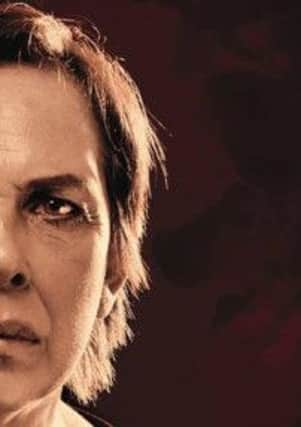Theatre review: Hecuba, Dundee Rep


It’s more than half a century, now, since theatre-in-the-round – or almost in the round – began to play a major role in British theatre; and as I watched Irene MacDougall’s terrific Hecuba prowl the Dundee stage, often just inches from the audience, I began to wonder about the strange dynamics that make this form of theatre so powerful on some occasions, and yet so unhelpful on others. There remains a kind of presumption in British theatre that working in the round has something to do with modernity and dynamism, and is almost always a good thing. The task of presenting drama on a wide canvas, facing an audience which sits in rows in the dark, is now so brilliantly accomplished by film and widescreen television – goes the argument – that theatre can hardly compete. Instead, it should play to its unique strengths, bringing living, breathing actors so close to the audience that we can smell their sweat.
And all of this certainly works in Amanda Gaughan’s production of Hecuba. Here, the heart of the drama lies in the character of the fallen queen – proud, vengeful, and utterly ravaged by grief – and in the words she speaks to the other characters around her; we can therefore only gain by seeing Irene MacDougall’s great performance up close, and from every angle.
Advertisement
Hide AdYet the last time Dundee Rep created a studio space on stage, in 2010, I remember being less impressed. The play was Peter Shaffer’s Equus, about a young boy’s religious and erotic obsession with horses; and somehow the in-the-round setting seemed to confuse rather than illuminate this study of the conflicting forces around the boy and his troubled psychiatrist – particularly the role of the stylised horses, who on a conventional stage can form a permanent half-circle around the action, ever-present, always watching.
It seems, in other words, that there are types of drama – perhaps more driven by ideas and the battle between them, more symbolic, more dependent on the visual sweep and balance of the stage – that thrive in a traditional end-on presentation, and begin to seem cluttered and confused when we cannot see the stage picture steadily and whole, choosing where to direct our gaze; Ibsen comes to mind, along with Arthur Miller.
And it also seems – as Hecuba demonstrates – that this distinction has nothing to with age or modernity, and everything to do with some intrinsic quality in the drama itself. This month, for example, the Royal Lyceum plays host to Dominic Hill’s brilliant staging of Chris Hannan’s new version of Dostoevsky’s Crime And Punishment, co-produced with the Citizens’ Theatre; it’s a dazzling piece of 21st-century theatre, making fabulous use of a fluid, open-stage theatrical style that shifts in an instant from words to music. Could it work in the round, though? I think not. To grasp its brilliance, we need to see the whole stage and society before us, like an ever-shifting series of pictures; not better or worse than Hecuba at Dundee, but driven by a different dramatic energy, and part of a theatre culture in Scotland that, at best, is gaining a wider expressive vocabulary with every passing year.
Hecuba is at Dundee Rep until today; Crime And Punishment is at the Royal Lyceum until 9 November